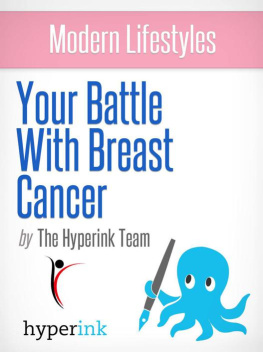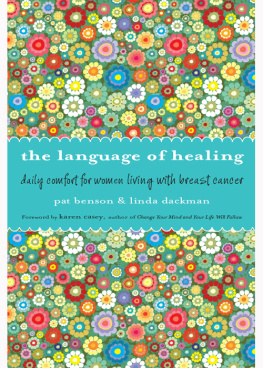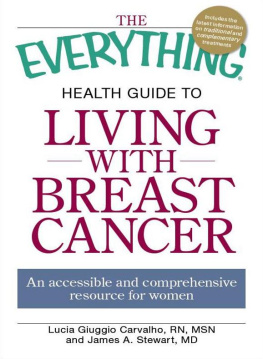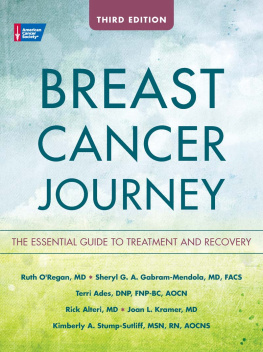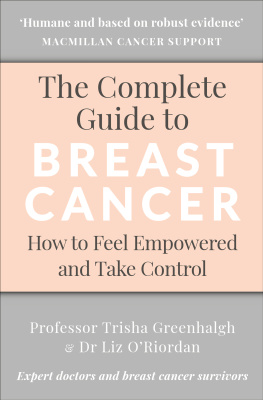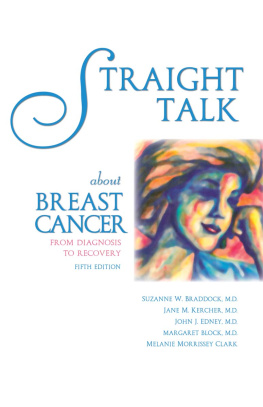To Bobby, Jenna, Amanda and Mattmy reasons for being
In Life in the Balance: My Journey with Breast Cancer, Dr. Marla Shapiro sensitively and perceptively describes the double pressures (and more!) of being a breast cancer patient as well as being a physicianand Canadas most well-known and much admired doctor at that.
In honest and accessible terms, she explains the emotional impact of the diagnosis, the effect it has on her, her family, her career and her sense of balance; in addition she portrays the deep urge to know the best route to follow at every medical crossroads and to be in control of her own treatment. As her book well shows, there are many difficulties entailed in that double role.
Perhaps the most significant message from this book is that there may not a single, obvious and compelling One Right Answer to every clinical problem. In many casesas illustrated well by Dr. Marlas conversations with Dr. Susan Lovethere may be several appropriate and acceptable answers, and the path that any person chooses may also depend on how that individual assesses the risks, the potential benefits, the side-effects, the impact of the treatment on the patient and the family andin its widest and most accurate meaningthe quality of life.
A large number of my patients with breast cancer have said how Dr. Marlas example inspires them, and makes them feel better able to cope and understand their situation. This book will greatly add to that effect and is a welcome portrayal of the difficulties, the obstacles, the setbacks and the frustrations as well as the victories, the gains and (unexpectedly) the benefits of potentially serious illness.
Dr. Robert Buckman, Medical Oncologist, Princess Margaret Hospital, and Professor, University of Toronto
PART ONE
OUTSIDE, LOOKING IN
ONE
Who I was
I have never been a superstitious person. After all, I am a doctor and have been trained to believe in science and evidence, to make a diagnosis and move forward with the best steps towards managementtrained to take control. But it is true that as a doctor there have been times when I was overwhelmed by the inability to take control, times when I have been powerless to intervene and could only stand by, hoping to make things easier, if not better. So it was ironic that on Friday the 13thAugust 13, 2004, to be exactI was diagnosed with breast cancer.
That diagnosis and everything that followed came to define my life for a time and would ultimately change me forever. It marked an invisible boundary, a before and after, by which everything in my lifeand in the lives of my husband and childrenwould be measured. As I stood in the hallway of the mammography suites, listening to the words suspicious for breast cancer, a feeling of powerlessness came over me. I knew I was taking a step into the world of after. I knew because I had been there before.
Almost eleven years earlier, on the morning of November 28, 1993, I woke with a start, a horrible sense of apprehension. As I walked down the hall to my infant sons room, I felt instinctively that it was too quiet. I began to run. Throwing open Jasons door, I knew that I would find him as I did: on his stomach, face down, dead. I remember picking him up, running, screaming, trying to resuscitate him, seeing the fear and disbelief on the faces of my older children. I knew there was no hope.
Within minutes of my husband calling 911, the fire department and police descended on our house, whisking Jason to the nearest emergency room. With bile in my throat, we got in the car and followed, then sat in the waiting room of the hospital, knowing that he was gone. When they finally came to confirm our worst fears, I could hear an agonizing scream come from somewhere deep inside. Our lifeless son was brought to us to say goodbye, his mouth bandaged from the trauma he had sustained during attempts to resuscitate him.
My son Jason, a perfect child in every way, a gift to a family that had already endured tragedy, was dead at five and a half months of age, of sudden infant death syndrome (SIDS). His death was like hitting a wall, no way to get through it, past it or around it. It marked the first invisible boundary in the life of our family, the first before-and-after moment.
Now, in 2004, we were all changed people, a changed family, but we had gone forward, living our lives, having been touched by Jason. With my diagnosis on Friday, August 13, we were about to change again.
On my 40th birthday, three years after Jason died and one year after the much-wanted birth of our son, Matthew, my girlfriends gave me a beautiful luncheon. Many of them had been traumatized at the thought of turning 40. I remember making a speech in which I said that turning 40 was a cakewalkit was getting to 40 that had been so damn hard.
At 48, facing a diagnosis of cancer, those words echoed inside my head as I wondered if I would make it to 50.
TWO
The first before and after
Let me backtrack a little and tell you how I got here. I am Dr. Marla, fashioned to be Canadas doctor, a role I have enjoyed creating and performing. My passion has been and continues to be medicinethe science, the art, the practice. I cannot remember a time when I did not want to be a doctor. As a little girl, I identified with characters on television who were doctors. I loved people. I loved scienceit seemed a natural place for me to end up. And it is a decision that I have never regretted. So few people love what they do and who they are. I, in fact, love it all.
Both my parents lived through the Depression years. It made them who they are and determined the kinds of lessons they would teach their two daughters. The first and most important lesson was education, education, education. It was hammered into us from an early age. No one could take away your education. Strive to be the best in whatever you wanted to be. If science was your interest, then reach for the pinnacle of medicine. If language was your interest, strive to become a lawyer. There were no halfway measures in their thinking.
My sister and I are only two years apart, but we are different and diverse people. My sister was formally named Roslyn at birth, but when an older cousin could not pronounce Roslyn, she became Rozzie and then Zozzie. I have known her as Zozzie my entire life. If anyone refers to her as Roslyn, I know that person is remote and does not know her. She is Zozzie. (It is even in the name of the business she has built for herself.)
The diversity of our early years set us apart and kept us apart. My sister is creative and artistic, and though in many ways far smarter than I am, her love was for imagination and design. Mine was always geared toward academic achievement. A university graduate, and now a brilliant designer, she was underappreciated in those early years because she did not meet what I perceived as the family expectation of getting straight As. I was the star pupil, and therefore far easier for my parents to relate to. Growing up in the same house with my sister, we might as well have lived in different countries. It must have been hard going to like me in the early years. I was always the standard by which other achievements were measured. It would not be until years later that my sister and I could see each other for who we both are and forge a deep and strong relationship. Now we can joke that I cannot draw a straight line even with a ruler, while Zozzie can create anything with her imagination. Together we are complete.
My mother was a French teacher. In fact she was the one and only specialty French teacher for the upper grades in the public school my sister and I attended. My sister took the option of a teacher who could simply teach the French curriculum, rather than having my mother as a teacher. I, ever the overachiever who thought that saying no was wrong, rose to the challenge of having my mother, Madame, teach me French. She was tough on everyone but tougher on me, aware that the other kids would assume I had an inside track. It was a miserable, almost impossible situation. I couldnt wait to move on to high school.



